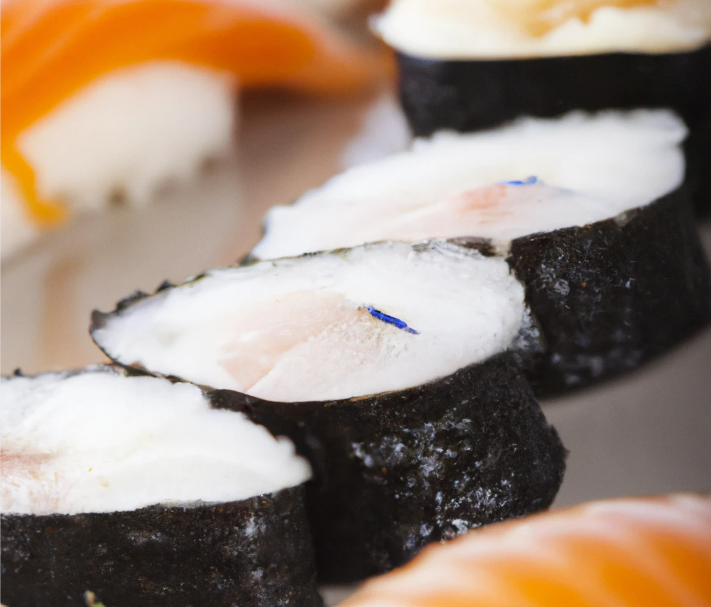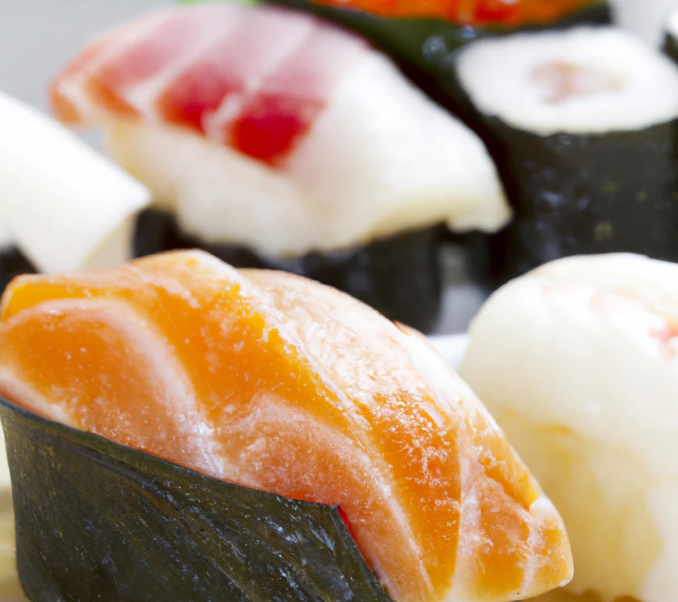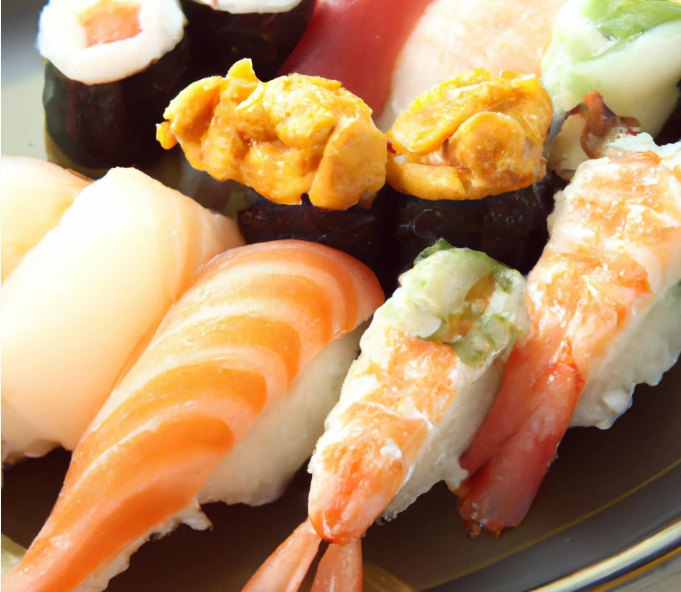Food etiquette involves general politeness as well as learning rules that may be associated with a food and its culture.
When partaking in Japanese cuisine like sushi, there are several traditions you can follow to help enhance your meal the next time you are out. Many rules for eating sushi are not absolute requirements, but it can be fun to experience and give it a try.
Table of Contents
Some of those rules are:
Irasshaimase
Arriving and being seated in a sushi restaurant begins with a traditional greeting of “irasshaimase,” which means “please come in.” Acknowledging this greeting is essential to being polite. You do not need to respond with anything other than a smile and to answer any questions the host may ask you. If the restaurant has a sushi bar and chef (itamae) and you would like to watch your food be prepared, be sure to ask to be seated there.
Ordering
Ordering is quite simple, no matter where you are seated. However, if at the sushi bar, only order sushi from the itamae. All other items, such as non-sushi items like sashimi, drinks, or soup, will be handled directly through the waiter or waitress. When speaking about the sushi, regardless if it’s with the itamae or with the wait staff, do not ask if the sushi is fresh. To be honest, if you have to question the freshness of the food, you should not eat there. This is considered an insult, especially to the itamae. Always ask what they recommend, as they will suggest what they think will be most satisfying to you and for you while also highlighting their sushi-making skills.
Be mindful of the itamae’s time and be respectful because he is pretty busy. You will be able to tell if you can engage him in conversation or not. They are well versed in preparing sushi and speaking with diners; otherwise, they would not be at the sushi bar. By being respectful and becoming a regular, you will often gain extra food, helpful information about the food.
While Dining
The saying, “my eyes were bigger than my stomach,” is not a saying you want to use in a sushi restaurant. It is considered impolite to leave food on your plate, so try to keep in mind your stomach and palate. If you are trying something new, only order one or try to share with your guest if possible.
Eating sushi will come with a few things such as a hot, wet towel (oshibori) and chopsticks. These items will arrive at the beginning of your meal. You will use the towel to wash your hands. Do try to fold it neatly before returning it to the waiter or waitress.
In regards to your chopsticks, they should not be rubbed together. When they are not in use, place the chopsticks on the holder parallel to yourself. If there is no holder, then they can be placed on the shoyu dish. When you are finished with your chopsticks, they need to be placed back in the holder or on the dish.
If there is an item you would like that you do not see on the menu, do not be afraid to speak up and ask for it. It is important to note that the sushi-ya may have seasonal or special items that are not listed. The itamae will appreciate your interest and is often happy to oblige the request.
Sauces and Symbolism

When eating nigiri-zushi (finger sushi), it will most often come with wasabi under the fish. This is done by the itamae and is his thoughtfulness to your palate and what he feels is the proper balance of wasabi to fish. It is here we should note that wasabi should not be put directly into the shoyu dish. When it comes to wasabi, some of us like more heat. If so, you can always sneak some onto the fish. You can eat nigiri-zushi (sushi) with your hands, whereas sashimi should only be eaten with your chopsticks.
When picking up the nigiri-zushi, dip only the fish into your shoyu. The rice should not be dipped in as it will soak up too much shoyu. Acting like a sponge, the rice will soak up too much, therefore overpowering the taste of the sushi. Also, the rice will ultimately fall into your shoyu dish.
If picking up food from a shared plate with your chopsticks, do no use the end that touches your mouth. Instead, use the end that you hold. This is considered the polite thing to do when sharing food with another. Keep in mind that when passing food, it should only be done by handing over the entire dish. Do not pass food with your chopsticks; this is considered symbolically to be like the passing of bones from a deceased relative at a Japanese funeral. Another reference to Japanese funerals is leaving your chopsticks sticking up out of a bowl of rice. This is reminiscent of incense sticks that are used for prayers for the ancestors at a Japanese funeral.
Eating the Sushi
Nigiri style sushi is to be eaten in one bite. If possible, try to eat in one bite, but do your best to eat in two bites. In North America, this is not always easy because the sushi-ya will make huge pieces. In traditional sushi restaurants, the pieces are more suitable for one bite. Just do your best and remember to enjoy the experience. When eating, use the gari (ginger) as a palate cleanser between bites of different sushi types. It is often considered a condiment, and this is incorrect. It is not meant to be eaten along with a piece of sushi because it subdues the flavor.
You may notice that soups do not come with spoons in Japanese restaurants, and therefore the soup should be sipped from the bowl directly. Slurping is considered ok for noodles, yet not so much for soup. Keep in mind that if a spoon is not given, do not ask for one. Immerse yourself in the experience and remind yourself that drinking from the bowl is the polite thing to do. If the soup should have solid pieces, use your chopsticks to guide them to your mouth.
Lastly, burping or belching is considered rude at the Japanese table. Although other Asian cultures are accepting of this behavior as a compliment to the food served, the Japanese do not. A traditional Japanese toast that is acceptable at a sushi restaurant would be “Kanpai!” which means empty your cup.
What to Drink with Sushi
Sake is not generally a drink to be had with sushi. It is either had with sashimi, or it is had before or after a meal. The reasoning behind not having sake with sushi is because both have rice in them; therefore, they do not complement one another. Appropriate drink options to have with sushi are water or green tea.
Serving drinks is a hierarchical custom. The usual thing to do is to allow the most popular or essential person at the table to pour and refill the drinks. For example, if dining with parents, the father or whichever is the eldest should serve the drinks. If not done by prestige, then serving should be done by the host who planned the event and sent the invite.
Other alcoholic beverages can be consumed with sushi, and it is considered customary to serve each other rather than pouring a drink for one’s self. Please do your best to be attentive to your friends while eating, and help in refilling their glasses. If a refill is needed, one should finish what is left in the glass and then hold it up towards a dining partner for a refill.
Sake, in particular, can be served both cold and hot, but this depends on the style of sake and its quality. When first trying sake, experiment, but go easy. Sake can pack quite the punch. Usually, a sake of higher quality will be served cold. When sitting at the sushi bar, remember to serve a beer or sake to the itamae. This will help him to remember you and treat you well currently and in the future.
After the Meal
After the meal, it is polite to thank the wait staff and the itamae for the meal if he is available. If you are seated at the sushi bar, you will find a tip jar to tip the itamae for his service. Do not try to hand the tip to the itamae, as he will not touch money while he is preparing the sushi. You will also need to tip the waiter or waitress for their service as well. It is important to note that in Japan, the tips are generally included in the bill. However, in North America, tipping is done as you see fit.
Speaking Japanese is always welcomed. If you want, you can tell the itamae and wait staff “Domo arigato,” which means thank you. You can try and say thank you for the meal for a more sophisticated response, which is “gochisosama deshita.” A less common saying, “oishikatta desu,” translates to it was delicious and can be said as well.
We hope this guide to etiquette while eating sushi will be helpful to you as you explore this popular Japanese dish. All the above is suggested, and we hope that you enjoy not only the food but the experience of the Japanese culture and all that it has to offer.


